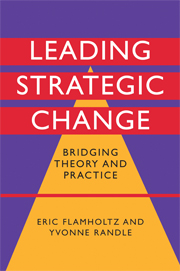Book contents
- Frontmatter
- Contents
- List of exhibits
- Preface
- Acknowledgments
- Part I An integrative framework for leading strategic and organizational change
- Part II Leading strategic change in actual organizations
- 4 Leading strategic and organizational change at Countrywide Financial Corporation
- 5 Leading change at Starbucks Coffee Company
- 6 Strategic marketing through HR interventions: a case study of Indian Oil Corporation
- 7 The evolution of Stan Tashman and Associates
- 8 Leading strategic and organizational change at IndyMac Bank
- 9 Leading strategic and organizational change at Infogix
- 10 Leading strategic and organizational change: the transformation of structure at Pardee Homes
- 11 Leading strategic and organizational change at Tata Steel: the role of culture
- 12 Leading strategic and organizational change at Westfield: transformation to a global enterprise
- Part III Leading strategic change: lessons learned from practice
- Appendix: References for further reading on leading change
- Index
5 - Leading change at Starbucks Coffee Company
from Part II - Leading strategic change in actual organizations
Published online by Cambridge University Press: 22 September 2009
- Frontmatter
- Contents
- List of exhibits
- Preface
- Acknowledgments
- Part I An integrative framework for leading strategic and organizational change
- Part II Leading strategic change in actual organizations
- 4 Leading strategic and organizational change at Countrywide Financial Corporation
- 5 Leading change at Starbucks Coffee Company
- 6 Strategic marketing through HR interventions: a case study of Indian Oil Corporation
- 7 The evolution of Stan Tashman and Associates
- 8 Leading strategic and organizational change at IndyMac Bank
- 9 Leading strategic and organizational change at Infogix
- 10 Leading strategic and organizational change: the transformation of structure at Pardee Homes
- 11 Leading strategic and organizational change at Tata Steel: the role of culture
- 12 Leading strategic and organizational change at Westfield: transformation to a global enterprise
- Part III Leading strategic change: lessons learned from practice
- Appendix: References for further reading on leading change
- Index
Summary
Starbucks Coffee is one of the truly great organizational success stories of the past two decades. “Starbucks” has become a worldwide brand, for many synonymous with lattes and cappuccino. Starbucks has become an icon of corporate success. Today, the company has more than 8,000 stores; it has more stores in California than all its major competitors combined.
If one looks closely at Starbucks, however, its success is not about its coffee; it is about the strategic and organizational changes that the company made to differentiate itself from its competition. These were led by Howard Schultz and his close associates, Orin Smith and Howard Behar. Together they formed the core leadership molecule (see chapter 3) that has created the phenomenon that is Starbucks.
Starbucks has accomplished this with a commodity product that has been around for quite some time: coffee. The company has led a strategic change not only inside the company but within the entire industry in which it operates. It is an amazing example of the role of leadership and management as a key ingredient in organizational success.
Howard Schultz, the founder and leader of Starbucks, had a strategic vision not only to build a national retail brand but also to “recreate the paradigm,” and transform coffee from a commodity product to a “truly exquisite product” with brand equity. This is exactly what he has accomplished with Starbucks.
- Type
- Chapter
- Information
- Leading Strategic ChangeBridging Theory and Practice, pp. 86 - 98Publisher: Cambridge University PressPrint publication year: 2008



